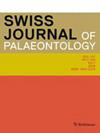圣乔治山贝萨诺地层(意大利/瑞士)中三叠世贝萨诺鱼龙(爬行纲:鱼龙目)的颅后解剖学,以及对重建三叠世鱼龙游泳方式的影响
IF 3
2区 地球科学
Q1 PALEONTOLOGY
引用次数: 0
摘要
Besanosaurus leptorhynchus Dal Sasso & Pinna, 1996最初是根据在贝萨诺(意大利)附近发掘的一个完整化石标本描述的。然而,最近的分类学修订和头盖骨学的重新研究使得该分类群又多了五个标本。在这里,我们详细分析、描述并讨论了贝萨龙的颅后解剖结构。本文所研究的标本大小从一米多一点到八米不等。总体而言,本文提出了该类群的几种诊断特征状态,展示了多同形和衍生特征的组合。最典型的例子是四肢,前肢显示出非常圆润的元素,脚趾趾骨保留着不成熟的轴。我们认为,贝沙龙前鳍的趾骨间距较大,嵌入了富含纤维软骨的结缔组织,就像现代鲸类动物一样。我们还回顾了贝散龙与栉龙和栉龙的相似之处,从而得出结论:贝散龙不是这两个类群中任何一个类群的小异名。最后,为了检验贝萨龙的游泳能力,我们对之前发表的一项研究进行了扩展,该研究的重点是重建鱼龙的游泳方式。研究发现,贝萨龙具有一种奇特的运动模式,介于鲶形游泳者(如鲤形龙和乌塔斯龙)和一些刹龙类(如贵州鱼龙)以及早期分化的鱼龙类(如加利福尼亚龙)之间。基于我们的研究结果,我们进一步提出,混合龙类获得其特征性身体轮廓(背鳍和前鳍与后鳍相比明显增大)是独立的,并与后来出现在副鱼龙类的身体轮廓趋同。此外,推断出的栉龙科、混龙科和贝散龙的不同游泳方式加强了早先关于贝萨诺地层中这三个不同鱼龙类群之间生态位分区的假说。本文章由计算机程序翻译,如有差异,请以英文原文为准。
Postcranial anatomy of Besanosaurus leptorhynchus (Reptilia: Ichthyosauria) from the Middle Triassic Besano Formation of Monte San Giorgio (Italy/Switzerland), with implications for reconstructing the swimming styles of Triassic ichthyosaurs
Besanosaurus leptorhynchus Dal Sasso & Pinna, 1996 was originally described on the basis of a single complete fossil specimen excavated near Besano (Italy). However, a recent taxonomic revision and re-examination of the cranial osteology allowed for the assignment of five additional specimens to the taxon. Here, we analyse, describe and discuss the postcranial anatomy of Besanosaurus leptorhynchus in detail. The size of the specimens examined herein ranged from slightly more than one meter to eight meters. Overall, several diagnostic character states for this taxon are proposed, demonstrating a mosaic of plesiomorphic and derived features. This is best exemplified by the limbs, which show very rounded elements in the forelimbs, and pedal phalanges with retained rudimentary shafts. We suggest that the widely spaced phalanges in the forefins of Besanosaurus leptorhynchus were embedded in a fibrocartilage-rich connective tissue, like in modern cetaceans. We also review the similarities of Besanosaurus with Pessopteryx and Pessosaurus, allowing us to conclude that Besanosaurus is not a junior synonym of either of the two taxa. Lastly, to test the swimming capabilities of Besanosaurus leptorhynchus, we expanded on a previously published study focussing on reconstructing the swimming styles of ichthyosaurs. Besanosaurus leptorhynchus was found to possess a peculiar locomotory mode, somewhat intermediate between anguilliform swimmers, such as Cymbospondylus and Utatsusaurus, and some shastasaur-grade (e.g., Guizhouichthyosaurus) and early-diverging euichthyosaurian (e.g., Californosaurus) ichthyosaurs. Based on our results, we furthermore suggest that mixosaurids acquired their characteristic body profile (dorsal fin and forefins that are distinctly enlarged compared to the hindfins) independently and convergently to the one that later appeared in Parvipelvia. Moreover, the different swimming styles inferred for Cymbospondylus, Mixosauridae, and Besanosaurus strengthen the earlier hypothesis of niche partitioning among these three distinct ichthyosaur taxa from the Besano Formation.
求助全文
通过发布文献求助,成功后即可免费获取论文全文。
去求助
来源期刊

Swiss Journal of Palaeontology
Earth and Planetary Sciences-Paleontology
CiteScore
4.30
自引率
16.70%
发文量
17
审稿时长
4 weeks
期刊介绍:
The Swiss Journal of Palaeontology publishes original research and review articles of interest to the international community in the fields of palaeontology, taxonomy and systematics, while recognising at the same time the importance of documenting high-quality palaeontological data in a regional context. Palaeobiology in combination with alpha taxonomy is a core topic of the journal.
Submitted papers should have an appeal as wide as possible, directed towards an international readership. Contributions should not have been simultaneously submitted elsewhere, and the overlap of content between related articles should be minimal. Duplications of text and the use of previously published illustrations without adequate citation are unacceptable. If a manuscript has two or more authors, both or all have to sign to confirm they all were involved in the work and have agreed to its submission. The preferred manuscript language is UK English, but consistently used US English is also acceptable. We encourage the publication of proceedings of international meetings as well as special thematic issues. Short contributions and book reviews are also accepted.
An international editorial team as well as guest editors guarantee that the thematic issues as well as all articles in regular issues are peer-reviewed and meet the highest standards.
 求助内容:
求助内容: 应助结果提醒方式:
应助结果提醒方式:


